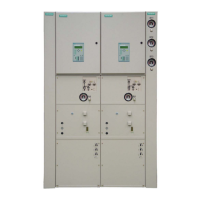fåëí~ää~íáçå
28 oÉîáëáçå=MP=G=fkpq^iiqflk=fkpqor`qflkp=Ua^=G=USNJVOTPKV=
Correcting contact overlap-
ping of disconnector con-
tacts
! Undo the lock nuts s at the hexagonal sleeve of the disconnector coupling rod a.
! Modify the length of the disconnector coupling rod a by turning the hexagonal
sleeve until the contact blades hold the fixed contacts centrally in the CLOSED
position.
! Tighten the lock nuts s again. Tightening torque: 20 Nm.
Mounting busbar housing
covers without desiccant
bag holders
For this reason, the busbar housing covers without a holder for desiccant bags are
mounted first (cover without "Filter" inscription).
! Remove tools, clean the inside of the housings with a hand vacuum cleaner, and
clean the bushing plates with a humid rag. To moisten the rag, use water containing
a common household cleaner. Then dry the bushing with a lint-free cloth.
! Prepare the flanges of the cleaned busbar housings for assembly (see Page 21,
"Preparing busbar assembly").
! Clean the contact surfaces of the busbar housing covers with a lint-free paper, and
apply a thin film of grease (see Page 21, "Preparing busbar assembly").
! Put the covers on the prepared flanges and bolt them tight crosswise. Tightening
torque: 20 Nm.
Bolting supporting frames
together
The supporting frames of the transport units are bolted together at the panel joints
using connecting links at the front and a connecting plate at the rear.
Fig. 19: Disconnector coupling rod
a
Hexagonal sleeve of the discon-
nector coupling rod
s
Lock nuts
ATTENTION!
In the ambient air, the desiccant bags lose their effectiveness rapidly and cannot be
used anymore.
! Use only desiccant bags whose packing is not damaged and whose humidity
indicators in the packing are blue.
! Do not use desiccant bags if the humidity indicators are pink.
! After opening the packings, mount the desiccant bags in the gas compartment
within 30 minutes and close the gas compartment hermetically.

